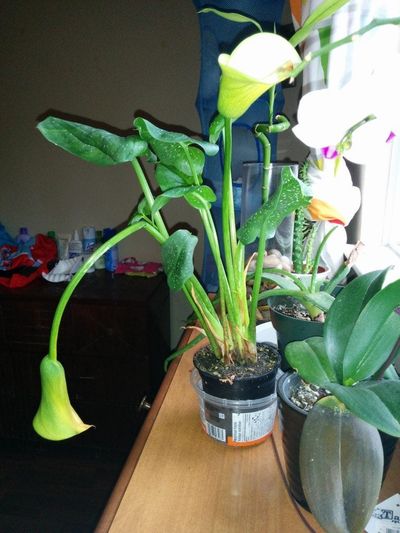Help! My Calla Lily is Drooping!
These plants are as lovely for their sword-shaped leaves as well as the cupped blooms. The leaves may become limp and drag if you have given the plant too much nitrogen fertilizer, which encourages leafy growth. They will also droop if the soil condition is too dry or too wet. The problem can also simply be that the blooms are too large. Stems may grow 2 to 3 feet (61-91 cm.) tall but they are slender and must support robust blooms up to 5 inches (13 cm.) long. Count yourself lucky if you are producing such huge flowers and cut them off and bring them indoors in a vase to enjoy. Leave the foliage until fall to gather energy for the bulb to store for the next year’s blooms.
How to Fix a Drooping Calla Lily Due to Water
There is no real method for fixing a drooping calla unless it is simply wilting. In that case, just give it a drink and it should perk up in a day or two. Callas grow from bulbs, which need to be planted in well drained soil and, if potted, in an unglazed pot that will allow excess moisture to evaporate. Drooping calla lilies occur if the bulb is steeped in water and the bulb begins to rot. Once rot has occurred, you will need to discard the bulb and start over.
Fungal Calla Lily Flower Droop
Cool, wet conditions contribute to the formation of fungal spores. When the warm weather hits, they bloom and spread causing all kinds of mayhem on a wide variety of plants. Soft rot is most common on calla lilies. This forms from spores in the soil that attack the bulb and stems of the plant. Once the stems get affected, they become mushy and pliable. This leads to the gardener who says, “Help, my calla lily is drooping!” Calla lily flower droop can stem from several fungal diseases such as Anthracnose and root rot. The best cure is to replace the soil if possible or simply start over with a resistant form of the plant.
Additional Calla Lily Problems
These bulbs will not tolerate freezing weather and even a quick frost can affect the leaves and blooms. In fall, cut back the spent foliage and move the bulb indoors for winter. Let it dry on the counter for a few days and then wrap it in sphagnum moss or newspaper in a mesh bag. Store where temperatures are not freezing and the area is dry. Replant the bulbs in spring as soon as soil temperatures have warmed to at least 60 degrees F. (16 C.). You can also start them in pots inside and transplant them for quicker blooms. Drooping calla lilies are usually just caused by easily controlled cultural conditions, so check your work and manage the bulbs for bountiful, beautiful blooms.
